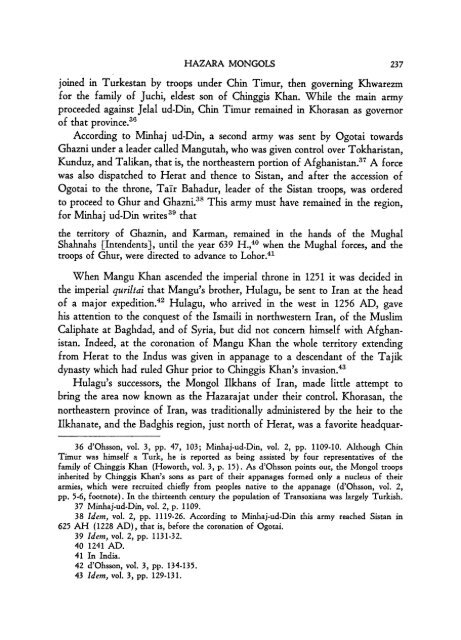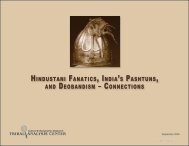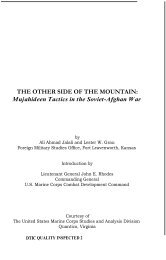the inquiry into the hazara mongols of afghanistan - Tribal Analysis ...
the inquiry into the hazara mongols of afghanistan - Tribal Analysis ...
the inquiry into the hazara mongols of afghanistan - Tribal Analysis ...
You also want an ePaper? Increase the reach of your titles
YUMPU automatically turns print PDFs into web optimized ePapers that Google loves.
HAZARA MONGOLS 237joined in Turkestan by troops under Chin Timur, <strong>the</strong>n governing Khwarezmfor <strong>the</strong> family <strong>of</strong> Juchi, eldest son <strong>of</strong> Chinggis Khan. While <strong>the</strong> main armyproceeded against Jelal ud-Din, Chin Timur remained in Khorasan as governor<strong>of</strong> that province.36According to Minhaj ud-Din, a second army was sent by Ogotai towardsGhazni under a leader called Mangutah, who was given control over Tokharistan,Kunduz, and Talikan, that is, <strong>the</strong> nor<strong>the</strong>astern portion <strong>of</strong> Afghanistan.37 A forcewas also dispatched to Herat and <strong>the</strong>nce to Sistan, and after <strong>the</strong> accession <strong>of</strong>Ogotai to <strong>the</strong> throne, Tair Bahadur, leader <strong>of</strong> <strong>the</strong> Sistan troops, was orderedto proceed to Ghur and Ghazni.38 This army must have remained in <strong>the</strong> region,for Minhaj ud-Din writes39 that<strong>the</strong> territory <strong>of</strong> Ghaznin, and Karman, remained in <strong>the</strong> hands <strong>of</strong> <strong>the</strong> MughalShahnahs [Intendents], until <strong>the</strong> year 639 H.,40 when <strong>the</strong> Mughal forces, and <strong>the</strong>troops <strong>of</strong> Ghur, were directed to advance to Lohor.41When Mangu Khan ascended <strong>the</strong> imperial throne in 1251 it was decided in<strong>the</strong> imperial quriltai that Mangu's bro<strong>the</strong>r, Hulagu, be sent to Iran at <strong>the</strong> head<strong>of</strong> a major expedition.42 Hulagu, who arrived in <strong>the</strong> west in 1256 AD, gavehis attention to <strong>the</strong> conquest <strong>of</strong> <strong>the</strong> Ismaili in northwestern Iran, <strong>of</strong> <strong>the</strong> MuslimCaliphate at Baghdad, and <strong>of</strong> Syria, but did not concern himself with Afghanistan.Indeed, at <strong>the</strong> coronation <strong>of</strong> Mangu Khan <strong>the</strong> whole territory extendingfrom Herat to <strong>the</strong> Indus was given in appanage to a descendant <strong>of</strong> <strong>the</strong> Tajikdynasty which had ruled Ghur prior to Chinggis Khan's invasion.43Hulagu's successors, <strong>the</strong> Mongol Ilkhans <strong>of</strong> Iran, made little attempt tobring <strong>the</strong> area now known as <strong>the</strong> Hazarajat under <strong>the</strong>ir control. Khorasan, <strong>the</strong>nor<strong>the</strong>astern province <strong>of</strong> Iran, was traditionally administered by <strong>the</strong> heir to <strong>the</strong>Ilkhanate, and <strong>the</strong> Badghis region, just north <strong>of</strong> Herat, was a favorite headquar-36 d'Ohsson, vol. 3, pp. 47, 103; Minhaj-ud-Din, vol. 2, pp. 1109-10. Although ChinTimur was himself a Turk, he is reported as being assisted by four representatives <strong>of</strong> <strong>the</strong>family <strong>of</strong> Chinggis Khan (Howorth, vol. 3, p. 15). As d'Ohsson points out, <strong>the</strong> Mongol troopsinherited by Chinggis Khan's sons as part <strong>of</strong> <strong>the</strong>ir appanages formed only a nucleus <strong>of</strong> <strong>the</strong>irarmies, which were recruited chiefly from peoples native to <strong>the</strong> appanage (d'Ohsson, vol. 2,pp. 5-6, footnote). In <strong>the</strong> thirteenth century <strong>the</strong> population <strong>of</strong> Transoxiana was largely Turkish.37 Minhaj-ud-Din, vol. 2, p. 1109.38 Idem, vol. 2, pp. 1119-26. According to Minhaj-ud-Din this army reached Sistan in625 AH (1228 AD), that is, before <strong>the</strong> coronation <strong>of</strong> Ogotai.39 Idem, vol. 2, pp. 1131-32.40 1241 AD.41 In India.42 d'Ohsson, vol. 3, pp. 134-135.43 Idem, vol. 3, pp. 129-131.
















